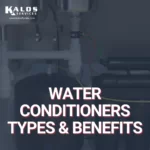In Central Florida, we see a mix of homes that receive public city water and those with their own private well system. Both systems have pipes that need flushing at least once per year, but the exact frequency and circumstances vary a bit between the two. In this quick post, we’ll clear up some differences between well and city water. We’ll also cover how often to flush each type of system and how to do a basic flush at home.
Well Water vs. City Water
A well system pumps water straight from the ground into your home’s plumbing. Wells are on your private property, so you wouldn’t pay monthly water bills to the city if you had one. However, YOU are also in charge of maintaining your own well, and that includes water quality testing and treatment.
If your home has a water meter, that means you use city water. This meter measures how many gallons of water the household uses, and you receive a bill for the amount used each month. The city should regularly test and treat the water. Your city should also publish the water quality test results.
Here is a quick breakdown of common differences between well water and city water:

Flushing Pipes
Flushing the piping is a common part of plumbing maintenance, and it’s something you can do without calling a plumber. A good flush removes contaminants and stagnant water that have been sitting around. Both city and well water systems will benefit from flushing at least yearly and whenever the water has a strange color or smell.
For city water, once per year is usually good enough. It doesn’t hurt to do it more often if your home has specific water quality or plumbing issues, though. It’s also a good idea to flush the pipes after plumbing work or long vacations.
Well water systems should be flushed once or twice per year. This number could be higher if your home is near farmland or your well is shallow. In Florida, we also have hurricanes and severe storms that can cause flooding. Floodwater may contain nasty contaminants, so you should flush your pipes after there is a heavy rain or flood.
In both cases, flushing has the following benefits:
- Remove sediment buildup
- Improve taste and odor
- Clear out stagnant water and biofilm
- Ensure optimal performance of filters and appliances
Additional Points to Consider for Well Systems
If you have a well, you should test the water quality before and after flushing. Testing the water quality BEFORE flushing helps find contaminants that we want to get rid of. Testing AFTER the flush can help you confirm whether those were removed or if they’re still in the water supply.
Since well water comes straight from the ground, sediment and minerals will find their way into your pipes. Minerals can stick to your pipes, but they can be removed or neutralized with a water softener or scale inhibitor.
Sediment buildup can reduce the lifespans of your water heater and pressure tank. Make a plan to flush these at least once per year, preferably twice a year, if you have a well on your property.
How to Flush Your Pipes
You can do a quick flush yourself by running all of the faucets and spigots for about five minutes. If you have a water softener or filter, you’ll want to bypass it. During this time, turn off your ice machine and do NOT drink the water.
Start by opening the outdoor tap(s) and letting the water run. Then, run the sink AND bath faucets, starting with the one closest to the water heater and working your way throughout the home. Remove the aerators from your faucets, if possible, and run COLD water through each one.
Keep all the fixtures running for about five minutes. Again, don’t drink water from your fridge or sinks at this time. After five minutes have passed, turn the fixtures back off in the opposite order you turned them on. Then, clean and replace the aerators. Some appliances may have special flushing methods; you can either follow the manual or call a plumber to help out.
Kalos Services has licensed plumbers, and we’d be happy to take a closer look at any issues with your home’s plumbing. Give us a call or text anytime at (352)-243-7099. We can send a plumber out to come up with a solution that works for you and your budget.






